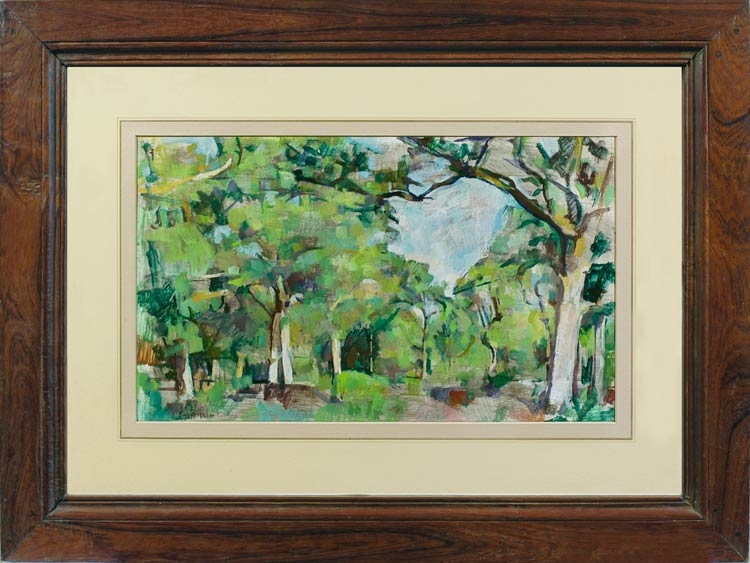Weissbort began his study of the great painters with those of the late 19th- early 20th century, Cézanne and Matisse, working backwards in time to the masters of the Renaissance. With this landscape, painted when he was only 24, he is still clearly under the influence of Cézanne; we can see how he applies principles learnt from the landscapes of Provence to this Austrian woodland, probing the underlying geometry of earth and trees, and depicting the lightfall through the flakes of foliage (compare this work with Cézanne’s Forest of Fontainebleau, private collection). This is a striking vignette, catching at once the transience of sunlight on the ephemeral masses of leaves, and the unchanging structures of the natural world.
Biographical details
George Weissbort (1928-2013) was born in Belgium and moved to London at the age of 7. He attended the Central School of Art & Design (now St Martin’s) where he was taught by Ruskin Spear and Rodrigo Moynihan. He was influenced by Arthur Segal to move from the abstract expressionism of the 1940s to realism, and by Bernard Meninsky, who taught life drawing at the Central School, to study the Old Masters. He turned first to artists such as Cézanne and Matisse, and later to Vermeer, Chardin, Velasquez, Corot, Titian, Holbein, and Piero della Francesca, amongst others.
He exhibited regularly at the Royal Academy, the Royal Society of Portrait Painters and the Fine Art Society. In 1964-65 he had a large exhibition in Paris, and in 2006 he had a one-man retrospective at the Chambers Gallery, London, followed in 2008 by another at the Denise Yapp Gallery, Whitebrook, Monmouth.
He wrote essays on art and criticism which look both at the techniques of making a painting, and of appreciating a work of art. The latter skill he believed came only after years of consciously training the eye to see as the artist saw, considering for example the ‘negative’ spaces around and between objects. He also discussed the work of specific artists, such as Lucien Freud and Vermeer.
His obituary in The Independent quotes Brian Sewell, a friend, as saying of him that Weissbort ‘painted the right pictures at the wrong time’. His appeal was to those who understood his models and influences; he could be described as a painter’s painter, and the same obituary quotes Paula Rego describing him as ‘a truly honest artist who knows so much about painting’.
Publications: George Weissbort, Paintings and Drawings (Parnassus, 2008), ill. 130 colour plates; includes transcripts of a filmed interview; essays by Tony Rudolph, David Lee and Bernard Dunstan RA.
YouTube video: A tribute to George Weissbort by John French.


